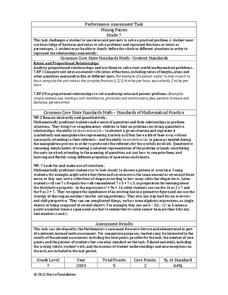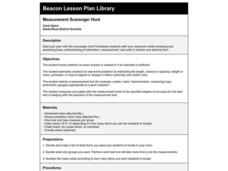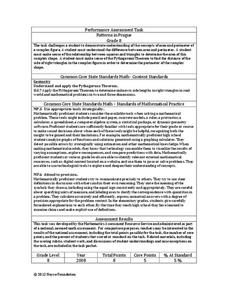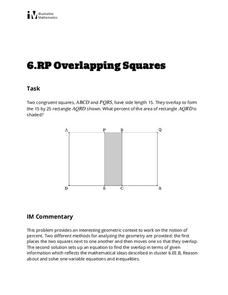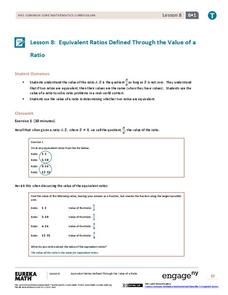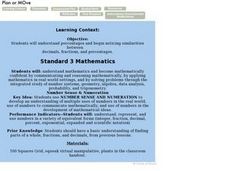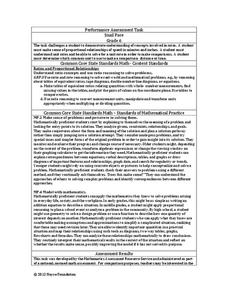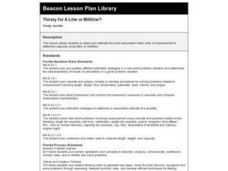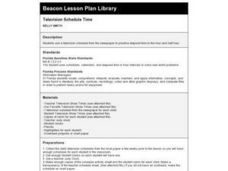Curated OER
Chances Are......You're Right
Young mathematicians study probability. In this math lesson, learners calculate odds, and convert those into percentages of probability. Fractions are also used, making this lesson quite rich in some of the more difficult conversions...
Virginia Department of Education
Properties of Quadrilaterals
What type of quadrilateral is that? Discover the difference between the types of quadrilaterals. Small groups investigate types of quadrilaterals using geometry software to find their properties. To keep track of the different...
Curated OER
Cemetery Restoration Project
Who is buried in this tomb? Trek to a local cemetery, take pictures of markers, explore records, and conduct interviews to bring to life the stories behind the stones. Use Olympus and Tool Factory to coordinate and gather information...
Curated OER
Anne Frank: Critical Thinking
Pupils examine the experience of Anne Frank during the Holocaust. Using the text, they discover how propaganda was used to impact the lives of young people in Germany. They answer discussion questions as a class and relate her...
Noyce Foundation
Building Blocks
Building blocks have more uses than simply entertaining children. Young mathematicians calculate the volume of a given cube, and then calculate the volume and surface area of a prism formed from multiple cubes.
Noyce Foundation
Mixing Paints
Let's paint the town equal parts yellow and violet, or simply brown. Pupils calculate the amount of blue and red paint needed to make six quarts of brown paint. Individuals then explain how they determined the percentage of the brown...
Noyce Foundation
Photographs
Scaling needs to be picture perfect. Pupils use proportional reasoning to find the missing dimension of a photo. Class members determine the sizes of paper needed for two configurations of pictures in the short assessment task.
Curated OER
What's Your Angle?
Third graders read the story, Magic Schoolbus Inside the Human Body. Then they form right, acute, and obtuse angles using the joints inside their bodies. They write a brief summary about what they learned about angles as a review the...
Curated OER
Measurement Scavenger Hunt
Students review estimation, measurement, fractions, decimals while familiarizing themselves with a new classroom at the beginning of the year.
Inside Mathematics
Patterns in Prague
Designers in Prague are not diagonally challenged. The mini-assessment provides a complex pattern made from blocks. Individuals use the pattern to find the area and perimeter of the design. To find the perimeter, they use the Pythagorean...
Inside Mathematics
Rugs
The class braids irrational numbers, Pythagoras, and perimeter together. The mini-assessment requires scholars to use irrational numbers and the Pythagorean Theorem to find perimeters of rugs. The rugs are rectangular, triangular,...
Illustrative Mathematics
Overlapping Squares
The objective of this activity is to find the percent of the area of a two squares overlapping. Mathematicians find the ratio of area for the part that overlaps to the rectangle formed. The final answer is a percent as a rate per 100....
EngageNY
Equivalent Ratios Defined Through the Value of a Ratio
Ratios may not be created equal, but they are equivalent. Pupils learn the theorem relating equivalent ratios and equal values in the eighth segment in a series of 29. Classmates use the theorem to determine whether ratios within various...
Cornell University
Beam Focusing Using Lenses
Explore optics using an inquiry-based experimental approach! Young scholars use a set of materials to design and build a unit capable of focusing a beam of light. They experiment with different lenses to determine the best approach to...
EngageNY
Percent and Rates per 100
What percentage of your class understands percents? Pupils learn the meaning of percents based upon rates per 100 in the 24th lesson in a series of 29. They represent percents as fractions, decimals, ratios, and models. The scholars...
Curated OER
Plan or Move
Learners note the similarities between decimals, fractions and percentages. They practice converting numbers between these types. They participate in an activity as well.
Noyce Foundation
Snail Pace
Slow and steady wins the race? In the assessment task, scholars calculate the rates at which different snails travel in order to find the fastest snail. Hopefully, your class will move much more quickly in finishing the task!
Curated OER
ExplorA-Pond: 4th Grade Perimeter Estimation
Your geometers are used to finding the perimeter of a square or rectangle, so give them something different this time! With this lesson, small groups will receive a picture of a shoreline and calculate the perimeter. The website listed...
Curated OER
Issue 1 - Designed to Add Technology Jobs
Young scholars research the statewide initiative on the Ohio ballot of 2003. They form teams to debate the issue of using bond proceeds to encourage technology research. The class votes on which individual/team presented the best...
Curated OER
Brown Eyes, Blue Eyes
Students are given certain privileges or have freedoms taken away based on their eye color to demonstrate what it feels like to be singled out by uncontrollable factors. In this singled out lesson plan, students discuss how it feels to...
Curated OER
Thirsty for A Liter or Milliliter?
Second graders work with liters and milliliters for measurement.
Curated OER
Mapping Possible Solutions
Fourth graders propose possible sites for the heart of Florida state capital by mapping collected data onto a Florida state map and recording data in a Travel Log.
Curated OER
Algebra/Geometry Institute: Area of Polygons
Students find the area of polygons. In this area of polygons lesson, students find the area of parallelograms, rectangles, squares, and other polygons. They identify each given figure and determine the appropriate formula needed to...
Curated OER
Television Schedule Time
Students consider the concept of elapsed time by examining television schedules. They list five television shows and highlight them in a newspaper, marking down the beginning and ending time of each show. They use clocks to figure out...







